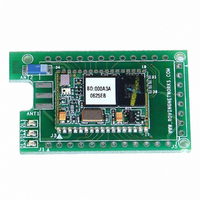RN-24S Roving Networks Inc, RN-24S Datasheet - Page 19

RN-24S
Manufacturer Part Number
RN-24S
Description
SUPERMODULE BLUETOOTH CHIP ANT
Manufacturer
Roving Networks Inc
Specifications of RN-24S
Frequency
2.4GHz
Data Rate - Maximum
721kbps
Modulation Or Protocol
Bluetooth v2.0+EDR, Class 1 & 2
Applications
Bluetooth v2.0
Power - Output
4dBm
Sensitivity
-80dBm
Voltage - Supply
4 V ~ 24 V
Current - Receiving
40mA
Current - Transmitting
40mA
Data Interface
PCB, Surface Mount
Antenna Connector
On-Board, Chip
Package / Case
Module
Wireless Frequency
2.402 GHz to 2.48 GHz
Interface Type
UART
Data Rate
240 Kbps to 300 Kbps
Modulation
FHSS, GFSK
Operating Voltage
3.3 V
Antenna
Chip Antenna
Board Size
20.32 mm x 50.8 mm x 4.08 mm
Lead Free Status / RoHS Status
Lead free / RoHS Compliant
Operating Temperature
-
Memory Size
-
Lead Free Status / Rohs Status
Lead free / RoHS Compliant
Other names
740-1008
6
6.1 Alternate Profile Selection
6.2 Using PIO as Modem Control Signals
Profile Settings and Features
www.rovingnetworks.com
will be returned. Leading zeroes will not be displayed. The value of GY may not match the value in the O
command due how the value is used as described above
The default profile is Serial Port Profile (SPP). The firmware also supports the DUN profile in both master
and slave modes.
To change the profile, use the “S~,<num>” command.
The most common use of DUN profile is to enable a BT client to connect to a dialup modem. For this mode,
use profile 1 (DUN DCE) via command “S~,1” . You may also want to set the Class Of Device so that
clients can recognize the device as a Bluetooth modem. The correct COD for a Bluetooth modem is
0x040210. This can be set using the commands below:
“SC,0004”
“SD,0210”
A new option available with version 4.74 firmware allows connection to Either SPP or DUN (but not both at
the same time) Both Services are displayed when a host discovers services, and either one can be chosen
and connected to. It is also possible to connect using SPP profile, disconnect, and then connect using DUN
profile.
The Firefly and RN-XX modules have the ability to replicate the required modem control hardware signals
automatically once a connection is made. These signals are transferred outside the data channel (using
RFCOMM control channels) and are automatically updated. The default SPP profile (profile=0) does NOT
drive these signals or report back inputs. If DUN or MDM profiles are enabled (profile =1,2, or 3), the
following signals are automatically driven and received.
Inputs: (read and sent back over Bluetooth to the remote host), Inputs are ACTIVE LOW.
PIO3 = DCD ( switch 2)
<num>
809 University Avenue
0
1
2
3
4
SPP
DUN -DCE
DUN-DTE
MDM SPP
SPP and DUN-DCE
Profile
•
Los Gatos, CA 95032
PIO6 = DSR (switch 3)
Default , no modem control
Slave or gateway
Master or client
With modem control signals
Multi-profile
~ 19 ~
•
Tel (408) 395-6539
Comments
PIO7 = CTS (switch 4).
rn-bluetooth-um Version 4.77 1/24/2011
Advanced User Manual
• info@RovingNetworks.com
























